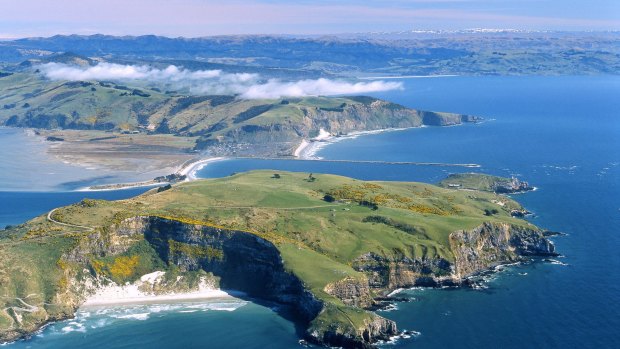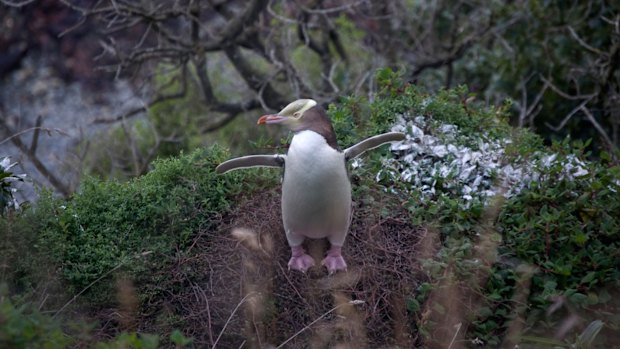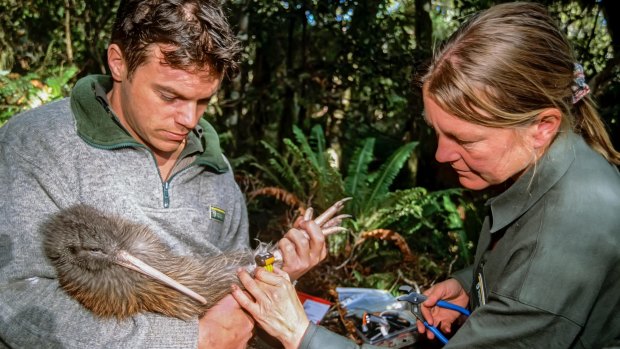This was published 7 years ago
Bird watching in Oamaru, South Island: Where to see birds and other wildlife in New Zealand
By David Whitley

Otago Harbour, New Zealand.Credit: Alamy
Underneath the boardwalk, one amorous couple isn't following the script. All eyes in the grandstands either side are focused on the sea, waiting for the evening's arrivals to shuffle ashore.
But it seems two of the Oamaru colony's inhabitants decided to stay at home and very much enjoy each other's company while everyone else is out fishing.
While that lusty pair give a graphic interpretation of what "breeding season" means for New Zealand's blue penguins, there is movement on the water. In the shallows at the edge of Oamaru's harbour, tiny backs appear, then heads. The first wave of the evening has arrived.

A yellow-eyed penguin near Oamaru.Credit: Alamy
The penguins are both tiny – they're only 30 centimetres tall and around one kilogram in weight – and adorably cute. But they're very nervous too. That's why cooing humans are kept well back in the stands, no photography is allowed, and the lighting is specially designed not to disturb them.
They know dangers can lie in wait on the journey back from sea to nest – be it a hungry sea lion or human-introduced nuisances such as dogs. So the initial steps up the rocky bank are quite ginger and wary.
But when they reach the top, it's as if they've been let off the leash. The diminutive birds – surprisingly muscular when you get a closer look – break into a run. It's not a dignified run by any stretch of the imagination. Short legs don't allow for that. And one completely loses it, tripping over and sliding on its belly for a few metres.

Phil Tisch Tansy Bliss Department Conservation Kiwi Recovery team affixing radio transmitter.Credit: Alamy
The targets are the little nesting boxes built into the hillside. Shaped like miniature houses, these have been put in place by the team managing the colony to give the penguins – and their chicks – a safe haven.
The efforts seem to be working, too. More than 200 individuals can come ashore in an evening, the birds grouping up and returning in waves of 20 to 40 at a time. This is a far cry from the few ragtag pairs living there when the project started in the 1970s.
If the Oamaru penguin colony is a small triumph for wildlife conservation, then the Orokonui Eco-Sanctuary about 100 kilometres to the south is a far bigger undertaking.
In the rural outskirts of Dunedin, the sanctuary takes over the bulk of a valley.
An 8.7-kilometre predator-proof fence has been constructed around the outside, with gaps so small even the smallest mice can't climb through. It has been structured so possums and cats can't climb over the top or leap from a nearby tree branch, while the bottom is extended underground to stop would-be burrowers getting underneath.
Poison drops and trap-setting have helped clear out the rats and mustelids (primarily stoats), leaving the valley free for the creatures that should be there. Walking along the tracks, little holes in the ground show that one of them has been foraging for worms.
The hunter is a Haast tokoeka, an extremely rare sub-species of kiwi. There are thought to be only around 350 of them left in their last remaining habitats on the remote West Coast. When the kiwis were reintroduced to Orokonui in 2010, they were the first to have lived wild in the Otago region for over 130 years.
Other near-extinct creatures have also been given the chance to thrive in an area they've long been chased away from. Tuatara, lizard-like relations of the dinosaurs that had previously been confined to a few tiny offshore islands, can be found scuttling around the deeper thickets of the forest.
And New Zealand's great conservation emblem, the distinctively chunky, red-beaked takahe, can be found strutting around near the entrance. For 50 years, the takahe was thought to be extinct until some were discovered in an isolated Fiordland valley in 1948. There are fewer than 300 in existence, but numbers are slowly growing with careful management.
New Zealand has a wealth of unique species, but the catastrophic events of the last 1000 years mean that wildlife enthusiasts don't get to see that much of them. The islands broke off from the Gondwana supercontinent before mammals rose to prominence, meaning the native birds never had to deal with them.
The birds got comfortable, getting large and flightless while evolving towards large lifespans, low numbers of children and long gaps between breeding. Then, around 800 to 1000 years ago – astonishingly late compared to the rest of the world – humans arrived, bringing with them dogs and rats. The native species were easy pickings for these new predators, while the Maori hunted large birds such as the moa for their meat. When the Europeans arrived in the 18th century with a whole new cavalcade of predators and an economic desire to strip habitats of trees, all hell broke loose.
The safe haven at Orokonui is a small, yet massively complicated, measure to redress the balance for the species that just about managed to survive.
New Zealand's coasts have done rather better than its inland areas for keeping wildlife stocks up, however, and the Otago Peninsula across the harbour from Dunedin is justifiably regarded as the country's animal-spotting hot spot.
This is where the MV Monarch has been running cruises for binocular-wielding birdwatchers since 1984. The vessel chugs around to the rocks near the Taiaroa Headland, the last chunk of terra firma for thousands of kilometres.
Said rocks are the favoured hangout of the local New Zealand fur seal population. The bull males can generally be found on their own, grumpily guarding their territory and occasionally leaving their sentry post to go romancing. They generally have six to eight females in a harem, and have very little to do with raising the utterly adorable pups splashing around in the rock pools.
Fluffy baby seals aside, however, the Taiaroa Headland is most noted for its birdlife. As the boat leaves the harbour for the open sea, the sky turns almost Hitchcockian. Scores of sea birds soar on the winds, keeping an eye out for an easy feed in the water below. With tides washing fish in and out of the harbour, it's a prime feasting spot.
Black-backed gulls, royal spoonbills and sooty shearwaters are amidst the circling swarm, but it's the big beasts that invoke awe. The gloriously aggressive giant petrels, wings furling out over two metres, seem intent on picking a fight with any perceived competition. The albatross, by contrast, seem effortlessly serene.
There are numerous albatross species that come to feed around the headland, gliding over the water with an astonishingly economical fixed wing technique. They lose more energy through heat loss in their feet when sitting on the water than they do from flying. Some northern royal albatross have even been known to fly to South America in a single flight, without stopping to eat or sleep. This we know because, for a small colony of northern royals, the Taiaroa Headland is home. It's the world's only albatross breeding colony on a human-inhabited mainland site, while full time rangers have been protecting and studying the population since 1951.
The tagging and monitoring programmes during that time have allowed the rangers to learn about the birds. The first flight, for example, sees the albatross leave the headland and not come back for four to six years.
But they always do come back to breed and rear their young. And that parenting process can be seen from inside an old fort on the top of the hill. They may be supremely elegant in the air, but that grace disappears the moment they hit land. From the slightly misted windows of the fort, it's possible to see the father return home from a couple of days of feeding himself up. He clunks to earth, then awkwardly lumbers towards his partner. It's his turn to sit on the egg until she returns.
As couples go, they're not as emboldened as the exhibitionist penguins or as preciously rare as the takahe, but it's still a remarkable privilege to get so close.
TRIP NOTES
MORE INFORMATION
GETTING THERE
One-stop options to Dunedin via Auckland or Christchurch are available from Melbourne and Sydney with Jetstar, Virgin Australia and Air New Zealand. See jetstar.com.au, virginaustralia.com or airnewzealand.com.au.
STAYING THERE
In Oamaru, the 19th century Brydone Hotel has old world atmospherics for from $NZ104 a night. See brydonehotel.co.nz. On the Otago Peninsula, the Camp Estate at Larnach Castle has tremendous views and surprising art deco flourishes for from $NZ379. See larnachcastle.co.nz.
TOURING THERE
The evening penguin viewing at Oamaru costs $NZ28, or $NZ40 for premium seats with better close-up views (penguins.co.nz). Tours, including a day's entry, at the Orokonui eco-sanctuary cost from $NZ30 (see orokonui.org.nz). The hour-long Otago Peninsula wildlife cruise with Monarch Cruises costs $NZ49 (see wildlife.co.nz). The Classic Albatross Tour at the Royal Albatross Colony costs $NZ45 (see albatross.org.nz).
FIVE MORE NZ WILDLIFE HOTSPOTS
GLOW-WORMS
Inside a cave on the western shore of Lake Te Anau in Fiordland, the torch lights are switched off. The roof and walls are then lit up by thousands of tiny glow-worms, as a tin boat floats through silently under a seemingly starry sky. See realjourneys.co.nz.
KIWIS
Stewart Island is the only place in New Zealand where kiwis are reliably active during the daytime. They can often be seen on Ulva Island or in the Rakiura National Park. Bravo Adventure Cruises runs trips to a remote beach where they hang out at night. See kiwispotting.co.nz.
DOLPHINS
The Bay of Islands in Northland offers sheltered waters popular with dolphins, and Fullers GreatSights runs half-day cruises that let you swim with them if conditions are right. See dolphincruises.co.nz.
WHALES
Kaikoura in the north-east of the South Island is generally regarded as New Zealand's whale-watching hot spot. Sperm whales are found off the coast year-round, while migratory humpbacks pass through in June and July. Whale Watch Kaikoura runs catamaran viewing tours. See whalewatch.co.nz.
STINGRAYS
Wild stingrays have been venturing into the shallows at Tatapouri on the East Cape of the North Island for years, happy to be hand-fed by humans. Dive Tatapouri runs reef ecology tours and snorkelling with stingray trips. See divetatapouri.com.
Sign up for the Traveller Deals newsletter
Get exclusive travel deals delivered straight to your inbox. Sign up now.